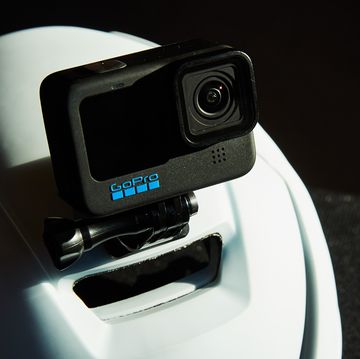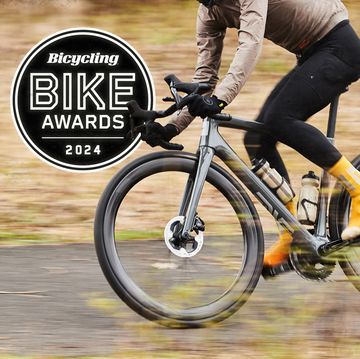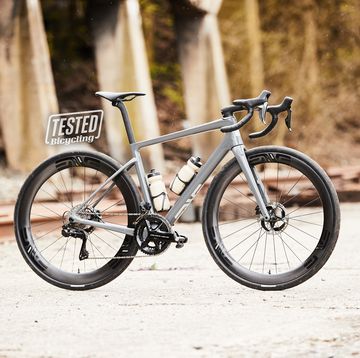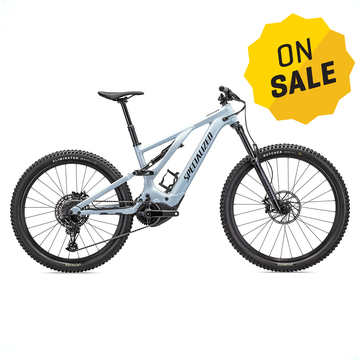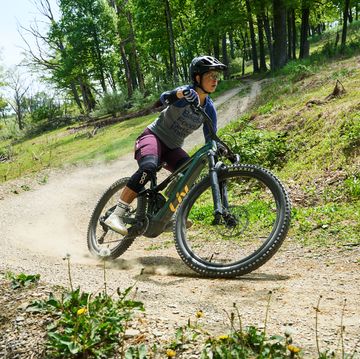Since the first Tour de France in 1904, racers have worn various forms of headgear for comfort, protection, and style. Those styles have evolved over the years: wool newsboy hats, brimmed cotton caps, leather hairnets, and a long list of wacky experiments in aerodynamics.
Though some purists argue that style went out the window in 2003, when certified hardshell helmets became mandatory, most riders today are happy to have the protection—even if we’ll never again witness the likes of Fausto Coppi and his perfectly pomaded coif slipping through the wind. Just like frames, wheels, and other components, today’s helmets are high-tech performance gear pieces, developed through advanced engineering and expensive helmet testing .
RELATED: 5 Great Helmets for Less than $50
Here’s a look at some of the most notable helmets we’ve seen over the years at the Tour de France.
Early 1900s to the 1970s: The Hairnet
The longest-lasting (to date) “helmet” style at the Tour was also the least effective for crash protection. In the early 1900s, racers began strapping on headgear made from strips of leather and wool. By the 1970s, some European countries including Belgium had begun to require helmets, and the hairnet became ubiquitous in the peloton among riders from those countries. The design and materials had evolved, too. Though the Tour didn’t mandate helmets until many decades later, some riders wore hairnets, such as this popular Cinelli Danish Helmet, all the way up until the 1990s. But lab tests eventually proved what was suspected all along—the hairnet provided little protection from impacts.
Tap or scroll your mouse over the image to find out more about this helmet. (Photo: Francois Xavier Marit/AFP/GettyImages)
1985: Cinelli Aerolite
The most lasting images of Bernard Hinault at the Tour are of a man in yellow, wearing nothing more for protection than a thick, brown shock of hair. But the Badger was an early adopter of new technologies, and he was always looking for an advantage in time trials. In 1985, his sponsor Cinelli created this Aerolite helmet, which was considered cutting-edge at the time. Wearing it, Hinault won the prologue, and went on to secure a record-tying fifth Tour title.
The Aerolite was created specifically for aerodynamic purposes, with no padding, no vents, and no features for crash protection on the road. Though aero cycling helmets had first emerged at track events including the 1984 Olympic Games, the Tour de France had never seen anything like the Aerolite. Its general profile—a plastic shell with a drop-tail shape—established a new design language for nearly every time-trial helmet that followed.
Related: 13 Awesome Aero Road Helmets from the Tour de France
Tap or scroll your mouse over the image to find out more about this helmet. (Photo: Courtesy of Speedplay)
1989: Giro Aerohead
Though the Cinelli Aerolite started the discussion, this is the helmet that legitimized the idea that aerodynamics matter in bike racing. And its design was a bit of an improvisation: When the UCI banned Greg LeMond’s longtail TT helmet after the 1989 prologue, his helmet sponsor Giro was prepared. “We built a shorter version and delivered it just prior to the Stage 5 time trial that Greg won,” said Giro GM Greg Shapleigh. “That was the big unveiling of Greg’s aero helmet and handlebars, and it signaled that he was a contender for victory.” LeMond came into the final stage TT 50 seconds behind GC leader Laurent Fignon. While Fignon raced with his ponytail flapping in the wind, LeMond attacked the 24.5km course in Paris wearing this radical snub-tailed helmet, which Giro called the Aerohead Bullet. He averaged close to 55kph, beat Fignon by 58 seconds, and won the Tour by eight seconds—the closest margin of victory ever.
Tap or scroll your mouse over the image to find out more about this helmet. (Photo: Courtesy of Giro)
1994: Limar F104
With a background in motorcycle helmets, Italian brand Limar produced its first expanded polystyrene (EPS) helmet in the late ’80s—a time when most European pros still raced with leather hairnets. Limar partnered with Gianni Bugno’s Gatorade team in 1993, and the two-time world champion said he wanted a lighter-weight hardshell helmet with better ventilation. Along came the F104, with 10 large vents, a tapered tail that was designed with wind-tunnel analysis, and a claim to be the world’s lightest road cycling helmet.
Tap or scroll your mouse over the image to find out more about this helmet. (Photo: Courtesy of Limar)
1994: Specialized Sub 6
By the mid 1990s, helmet designs were getting steadily lighter. Then along came the Sub 6—unveiled at the 1994 Tour with Team Motorola. As the name suggests, it had a claimed weight of less than six ounces (170 grams)—crazy light, even by today’s standards. “I hated every helmet out at the time,” said Specialized creative director Robert Egger. “I wanted something that was as comfortable as a hairnet, because that’s what I used to wear.” The Sub 6 featured large air vents and lacked any type of hard shell or fabric cover—but it became a functional, widely available helmet that passed the safety certifications of the time. It didn’t even have a fit system, just simple straps secured with double-sided tape. Egger helped fit Motorola riders including Lance Armstrong, who appreciated the light weight and ventilation, even if it meant doctoring up the foam to get a perfect fit.
Tap or scroll your mouse over the image to find out more about this helmet. (Photo: Gary Newkirk /Staff/GettyImages)
1999: Giro Rev V
Throughout the late 1990s and early 2000s, aero-helmet designs went big and bold. Long, pointy tails. Integrated eye shields. Smooth, frontal surfaces devoid of air vents. Most credit Lance Armstrong’s trusted aerodynamics guru John Cobb for this trend. Working with Armstrong at the Texas A&M wind tunnel, Cobb came up with the idea for the Rev 5. “Cobb’s concept was to keep it aerodynamic even when Lance dropped his head and the tail of the helmet stuck up in the air,” said Giro GM Greg Shapleigh. Giro’s team built and delivered a prototype just before the prologue of the 1999 Tour. Armstrong won the prologue and two individual time trials, and competitors went on to mimic the design for years. Since helmets still weren’t mandatory at the Tour, these were really just head fairings—plastic shells made for aero enhancements, not protection, and the Rev V was never produced for consumers.
Tap or scroll your mouse over the image to find out more about this helmet. (Photo: Joel Saget/AFP/Getty Images)
2008: Specialized S-Works 2D
Following the death of Andrei Kivilev from a crash at Paris-Nice, the UCI finally made helmets mandatory for the 2003 Tour. A new era unfolded as manufacturers scrambled for designs that could pass certifications (and the fickle demands of riders). Weight was an issue, as always. So when Specialized introduced the 2D at less than 200 grams, a full 30 percent lighter than the model it replaced, it set a new standard. The name references its key technology: dual-density foam. The side sections featured high-density foam, while the center/top parts used lower-density foam. Worn by a number of pro teams including Gerolsteiner, Silence-Lotto, and Lampre-Fondital, the 2D had a huge horizontal port in front and tall, fin-like vertical exhaust ports in the back. A Kevlar fiber internal skeleton held it all together.
Tap or scroll your mouse over the image to find out more about this helmet. (Photo: Pascal Pavani/AFP/Getty Images)
2012: Giro Air Attack
The Air Attack debuted at the 2012 Tour. Chris Bullock, a contracted helmet designer who has done work for Giro, Specialized, and Giant, connects the dots for the Air Attack back to a Giro concept helmet known as the “Bug” that was originally created before the 1992 Olympics. Almost 20 years later, the Garmin-Sharp team had the idea for a sprinters’ helmet. “They wanted domestiques to drop back to the team car before the finish and swap helmets for the sprinters,” Bullock said. Giro looked back at the Bug, implemented some of its core design ideas, and created the “sprinters’ helmet” for the Garmin team. Two years later, it debuted at the Tour as the Air Attack aero road helmet. Giro claimed that the Air Attack had 12 percent less drag and 97 percent of the cooling power of its Aeon road helmet.
Tap or scroll your mouse over the image to find out more about this helmet. (Photo: Courtesy of Giro)
2014: Bell Star Pro
Two years after the arrival of aero road helmets, Bell introduced a new twist called “Active Aero.” The Star Pro model, launched with the Belkin squad at the 2013 Tour, allowed racers to switch the helmet’s aero mode on or off while riding. The idea was simple: In its aero mode, the Star Pro reduced drag like any other aero helmet. But the vents could also be opened via a simple slider button on top of the helmet. The Star Pro also featured an integrated eye shield with a magnetic mount. The design worked well enough for Belkin rider Lars Boom, who scored a solo win on Stage 5, a brutal day of rain, wind and cobblestone roads in northern France.
Tap or scroll your mouse over the image to find out more about this helmet. (Photo: Courtesy of Bell)
2014: Kask Protone
With the reigning Tour de France champion Chris Froome on its squad, the big-budget Team Sky was known to spare no expense in developing technological advantages. While most teams were still caught in the arms race to have an aero road helmet offering (17 of 22 came to the 2014 Tour with some sort of aero road helmet), Sky showed up with this prototype Kask Protone. Designed to combine cooling technology with aero performance, the Protone seemed to swing the pendulum in the opposite direction. Rather than having a vent-free bowling ball shape, it featured wide-open frontal vents and sharp lines. According to Kask, the idea was to focus more on real-world comfort and how aero performance is affected by variables like rider posture and even where you place your sunglasses on the helmet.
Tap or scroll your mouse over the image to find out more about this helmet. (Photo: Mitch Mandell)
Related: Giro Synthe MIPS Helmet Is a Head Protection Game-Changer
2015: MIPS System
Swedish helmet manufacturer POC was the first to use Multidirectional Impact Technology (MIPS) in cycling helmets. The MIPS system is based on 19 years of academic research and trials in Sweden, and uses a low-friction interior liner with an elastomeric attachment system, which the manufacturer claims will help to reduce the risk of injuries. In angled impacts, the MIPS system allows the foam liner of the helmet to independently rotate just a few millimeters around the rider’s head and redirect energy, and some tests show that MIPS can reduce the amount of rotational force transferred to the brain in certain impacts. While POC was first to use MIPS in a cycling helmet, the Giro Synthe, just launched this month, is the first to be used at the Tour de France. Three teams—BMC, Katusha and IAM—are using it at the Tour.
Tap or scroll your mouse over the image to find out more about this helmet. (Photo: Courtesy of Giro)


